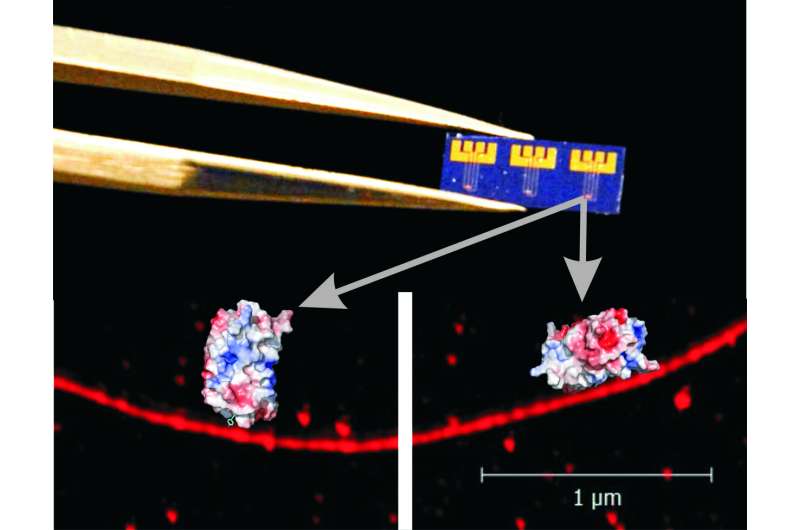Genetically modified proteins convert carbon nanotube to programmable optoelectronic device

Fluorescent proteins, especially green fluorescent protein (GFP), can act as the light-responsive element that transduces events through to electrically conductive transducers, such as single-walled carbon nanotubes (SWCNTs) and graphene. SWCNTs' conductance and optical properties make them particularly useful for generating active bionanohybrid systems, especially as their inherent properties can be altered through chemical modifications.
In recent research, optically active proteins were used to modulate conductance across an individual SWCNT transistor. The research team, which includes scientists from the UK, Russia and Serbia, has just published the results in the journal Advanced Functional Materials.
Researchers used genetically encoded phenyl azide (azF) chemistry to directly photo-link GFP to a carbon nanotube transistor. Two different GFP variants with azF at two different positions—close to the chromophore and further from the chromophore—were used to control the attachment site.
The electronic chip is based on individual carbon nanotubes with known chirality to explore its optoelectronic properties in the presence of a countable number of fluorescent proteins. The modulation of the conductivity in a modified carbon nanotube transistor is selective, and only possible when the structure is irradiated with light at a specific wavelength corresponding to the maximum absorption of the chromophore in a fluorescent protein.
Dr. Ivan Bobrinetsliy, a senior researcher at Biosense Institute, said the most exciting result is that the "GFP attachment site dictates the modulation properties of a carbon nanotube."
"What is causing these different effects is different charge transfer pathways available to GFP between the chromophore and carbon nanotube, especially the route back under dark state."
One of the lead authors, Nikita Nekrasov, a Ph.D. student from MIET, said "The research demonstrated the fundamental discovery in [the] ability of biological molecules to manipulate the electronic properties of carbon nanotubes due to the change in [their] relative position. Bio-optoelectronic interfaces with carbon nanotubes are promising for fabricating energy-efficient phototransistors to build 'green' photonic integrated circuits."
These results pave the way to the development of novel molecular optoelectronics, biosensors and photovoltaic elements. Using a multiarray of carbon nanotube transistors with various genetically encoded proteins makes it possible to design full spectra miniature optoelectronic elements.
In addition to the design of single-molecule electronic and photonic devices, the usage of optical methods for carbon nanotube modification is highly scalable and can become the basis for biodegradable and environmentally friendly solar cells and optoelectronic memory production for photonic integrated circuits.
More information: Rebecca E. A. Gwyther et al, Differential Bio‐Optoelectronic Gating of Semiconducting Carbon Nanotubes by Varying the Covalent Attachment Residue of a Green Fluorescent Protein, Advanced Functional Materials (2022). DOI: 10.1002/adfm.202112374
Journal information: Advanced Functional Materials
Provided by AIMEN




















